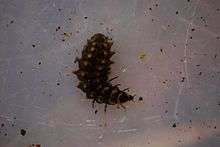Luciola cruciata
Luciola cruciata, known as "genji-botaru" in Japanese, is a species of firefly found in Japan. Its habitat is small ditches and streams, and its larvae are aquatic.
| Luciola cruciata | |
|---|---|
 | |
| Larva | |
| Scientific classification | |
| Kingdom: | |
| Phylum: | |
| Class: | |
| Order: | |
| Family: | |
| Subfamily: | |
| Genus: | |
| Species: | L. cruciata |
| Binomial name | |
| Luciola cruciata Motschulsky, 1854 | |
Taxonomy
This species was described by Victor Motschulsky in 1854.[1] The type locality is Japan, but it was incorrectly given as Java.[2] Its Japanese name, "genji-botaru", may derive from The Tale of Genji, an 11th-century Japanese novel, or it may derive from the Genji clan, which won the 12th-century Genpei War.[3] (Another, smaller firefly species, Aquatica lateralis, has the Japanese common name "heike-botaru", a possible reference to the Heike clan, the losers in the Genpei War).[3]
Description
The male is 10.5–16.5 mm (0.41–0.65 in) long and 3.0–5.0 mm (0.12–0.20 in) wide. The female is larger, 15.0–18.6 mm (0.59–0.73 in) long and 5.0–6.0 mm (0.20–0.24 in) wide. The pronotum is reddish pink, with a central marking. The black elytra are elongate. In the male, the venter is brown and pale yellow, and in the female, it is brown, yellow and reddish pink. The male's luminous organ occupies its sixth ventrite.[2] The antennae, about 6 mm (0.24 in) long, are between the eyes, which are well developed.[4] The larva's body is soft, with gills. It has defensive organs that are eversible (can be turned inside out).[5]
Distribution and habitat
This species occurs throughout Japan, except Hokkaido and Okinawa.[6] There is one unconfirmed record from Korea. Its habitat is small ditches and streams, with mud or pebbles at the bottom. Adults are found from May to July.[2]
Behaviour and ecology
Larvae of Luciola cruciata are aquatic; unable to swim, they crawl at the bottom.[5] They prey on Semisulcospira libertina snails.[7] They have six to seven instars.[2] The fireflies emerge from underground pupae around June.[4] Maturity is reached in more than one year.[6] Adults live for less than three weeks, and they do not eat anything.[4] Their flash communication system is known as the "complex system". The flying males flash synchronously; the females do not fly while flashing, and their flashes are not synchronized. The male's flash pattern changes when it perches near a female, which emits single pulses. The male then approaches the female, and they copulate. In western Japan, there are two seconds between the male's flashes, and in northern Japan, there are four seconds. Intervals of three seconds occur between these two populations.[6] The female lays 500–1000 eggs. In western Japan, females lay eggs in groups, but they are solitary in eastern Japan.[2]
References
- Motschulsky, V. (1854). "Lampyrides (fin)". Etudes Entomologiques (in French). 3: 53. Archived from the original on 2018-01-26.
- Jeng, M. L.; Lai, J.; Yang, P. S. (2003). "Lampyridae: A synopsis of aquatic fireflies with description of a new species" (PDF). In Jäch, M. A.; Ji, L. (eds.). Water Beetles of China. 3. pp. 539–562. Archived (PDF) from the original on 2017-12-22.
- Corkill, Edan (13 June 2008). "Fireflies set the nights alight". The Japan Times. Archived from the original on 28 December 2017. Retrieved 26 December 2017.
- Iwasaki, Masayuki; Itoh, Tsunao; Yokohari, Fumio; Tominaga, Yoshiya (1995). "Identification of Antennal Hygroreceptive Sensillum and Other Sensilla of the Firefly, Luciola cruciata". Zoological Science. 12 (6): 725–732. doi:10.2108/zsj.12.725.
- Fu, Xinhua; Ballantyne, Lesley; Lambkin, Christine L. (2012). "The external larval morphology of aquatic and terrestrial Luciolinae fireflies (Coleoptera: Lampyridae)". Zootaxa (3405): 1–34. doi:10.5281/zenodo.211302. Archived from the original on 2017-12-22.
- Ohba, Nobuyoshi (2004). "Flash Communication Systems of Japanese Fireflies". Integrative and Comparative Biology. 44 (3): 225–233. doi:10.1093/icb/44.3.225.
- (in Japanese) Moriya S., Yamauchi T. & Nakagoshi N. (2010). "Sex ratios in the Japanese firefly, Luciola cruciata (Coleoptera: Lampyridae) at emergence". Japanese Journal of Limnology 69(3): 255–258. doi:10.3739/rikusui.69.255.
External links
| Wikimedia Commons has media related to Luciola cruciata. |